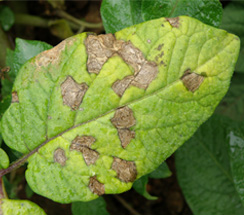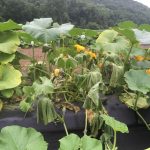
PATHOGEN: Alternaria solani
Disease symptoms:
Symptoms of early blight occur on fruit, stem and foliage of tomatoes and stem, foliage and tubers of potatoes. Initial symptoms on leaves appear as small 1-2 mm black or brown lesions and under conducive environmental conditions the lesions will enlarge and are often surrounded by a yellow halo Lesions greater than 10 mm in diameter often have dark pigmented concentric rings.
infection of both green and ripe tomato fruit normally occurs through the calyx with lesions sometimes reaching a considerable size. The lesions appear leathery and may have the characteristic concentric rings. Infected fruit will frequently drop prematurely. Symptoms on potato tubers are characterized by sunken, irregular lesions which are often surrounded by a raised purple border. Beneath the surface of the lesion the tuber tissue is leathery or corky with a brown discoloration. Early blight lesions on tubers tend to be dry and are less prone to invasion by secondary organisms than lesions of other tuber rots. After prolonged storage severely, diseased tubers may become shriveled.
- Normally the disease symptoms become apparent during tuber bulking stage and develop leading to the harvest.
- The early blight is first observed on the plants as small, black lesions mostly on the older foliage.
- Tissue surrounding the spots may turn yellow. If high temperature and humidity occur at this time, much of the foliage is killed.
- Lesions on the stems are similar to those on leaves, sometimes girdling the plant if they occur near the soil line
Favorable conditions:
Warm, rainy and wet weather
Disease Management
Consideration should be given to removing potentially infected material such as decaying vines and fruits from the vicinity of production fields. Controlling volunteers and weeds, such as nightshade and horse nettle which serve as alternative hosts for the disease, prior to planting the new crop will help to reduce the risk of transmission of disease.
During the season, overhead irrigation schedules should minimize the duration of leaf wetness in the crop. Avoid irrigation in cool, cloudy periods or late in evening when foliage may stay wet for extended periods. Selecting fields with good drainage and an absence of natural impediments to air flow over the crop, e.g. rows of trees, will reduce periods of leaf wetness. Maintenance of adequate soil fertility levels is also critical for managing early blight. The disease is often associated with crops suffering from a lack of nitrogen, particularly towards the end of the growing season on older senescing foliage.
Resistant cultivars:
Complete resistance to early blight does not exist in commercial potato or tomato cultivars. Using wild Lycopersicon species which show a high degree of resistance in breeding programs has led to the release of a number of cultivars of potato and tomato with a degree of resistance to early blight. Apparent levels of resistance are often correlated with plant age. Immature potato and tomato plants are relatively resistant to early blight but, after tuber and fruit initiation, susceptibility increases gradually, and mature plants are very susceptible to the pathogen.
Chemical Control:
Fungicides with protectant and curative properties are registered for use against early blight on tomato and potato. The protectant fungicides such as mancozeb and chlorothalonil are the foundation of most early blight management programs. These fungicides must be reapplied every 7-10 days to provide protection of new growth as well as to counter the effects of weathering which progressively removes the chemical from the leaf surface.





